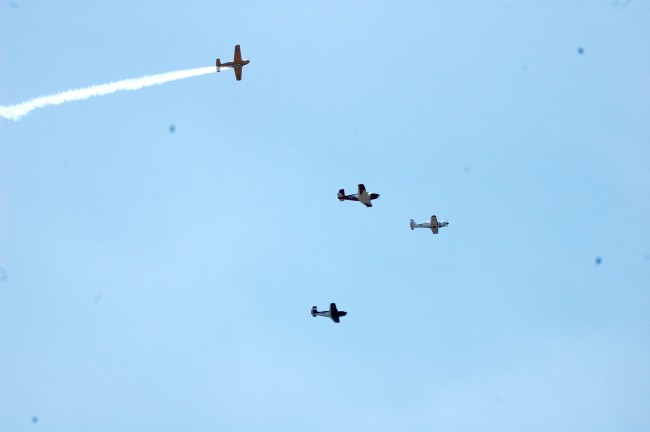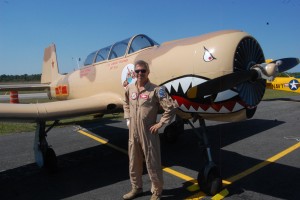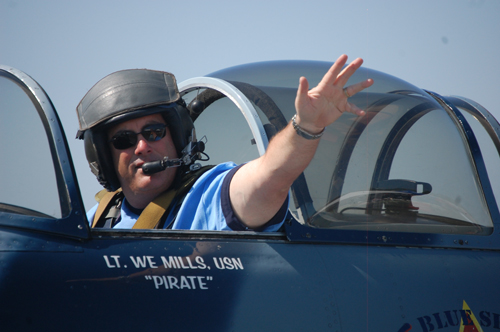
At 11:45 this morning they powered up, eight single-engine planes that turned the western end of the tarmac at the Flagler County Airport into a thunderous roil under blue skies. By noon, after taking off in pairs, they were airborne—Pirate, Smiley, Med and Hoot in one formation, Chunks, Pod, Paine and John, as they’re known by their pilot’s names, in another. They disappeared for a while, going east toward Flagler Beach, then reappeared 12 minutes after noon, first as eight dots in the distance, then as two formations about to do what no pilot likes to do, and every pilot does proudly when necessary: pay tribute to one of their own.
Click On:
- Single-Engine Yak 52 Crashes at Wings Over Flagler; One Pilot Is Dead; Tribute on Sunday
- Video: The Crash Scene Shortly After the Yak-52 Went Down at Wings Over Flagler
- Wings Over Flagler: Warbirds, Yakrobatics and Tributes This Weekend at the County Airport
- Red Thunder Air Show Team’s Facebook Page
With Pirate—Bill Mills, the Wings Over Flagler organizer—in the lead, the first formation approached the open fields of the airport, from east to west, many hundreds of people below craning necks toward the sky. The planes were literally 36 inches from each other, wing to wing. Mills’s plane began trailing a white plume, smoke more ceremonial than showy this time, as the formation approached the field’s midpoint, where most people were gathered. The planes flew low, they seemed to fly silently. Then Med, or Lt. Col. Ahmed Ragheb, third man in the formation, pulled his Nanchang CJ6 up and away, leaving a void of blue in the formation: a lost pilot.
That lost pilot was Bill Walker, better known as Wild Bill, the 58-year-old father of three and 30-year veteran of commercial and aerobatic flying, and a member of Alabama’s Red Thunder Air Show Team. On Saturday, while performing a maneuver he’d performed several times that day and innumerable times in his career in his Yak-52, Walker’s plane dropped out of the sky and crashed at the wooden edge of the airport as the late afternoon crowd watched, a half hour before the end of the first day’s shows. Walker was killed. No one knows what failed yet.
The formation behind Mills’s did the same. By 12:20, five of the eight planes were back on the ground. The three others flew on home, beginning the wind-down of the second annual Wings Over Flagler fly-in.
Walker’s teammates, three of whom had flown with him 19 hours earlier, watched from the ground. Then they left, but not in their own planes. One of them drove home. Two others were flown on different planes. Mills will safeguard their three planes in a hangar at the airport. Two hours later, four T-34 pilots from New Smyrna Beach performed the same maneuver in Walker’s honor.
“It’s a standard thing we do for our fallen pilot,” Med—Lt. Col. Ragheb, who’s had to do the maneuver several times in his military career and since—said shortly before climbing into his cockpit.
Video: Charlotte Marten’s Report on Sunday’s Activities[media id=175 width=350 height=300]
An air show is an encyclopedic collection of stories and history in aluminum, steel and flesh. Ragheb is one of those stories. A native of Egypt, the son of an Egyptian father and a Lebanese mother, he served in the U.S. Air Force from 1971 to 2000, retiring as a Lieutenant Colonel, and now, as part of the Red Star Pilot Association, flies the Chinese military trainer his wife called Miss Stress in many shows. He’d flown with Bill for many years. But there was no place for emotion up there. “You are basically flying in your position. Your training takes over, same thing like you’re flying combat,” he said. “Emotions are when we’re sitting out here and maybe later on, but not in the cockpit.”
Ragheb didn’t return after the tribute. He flew north to Savannah, where he lives, and where some bad weather required a few pilots to leave early. He was too modest to speak about one of his distinctions. Mills filled us in: “He was the first fighter pilot on station during Desert Storm,” Mills said of Ragheb, referring to the name given the 1991 coalition counter-attack on Saddam Hussein’s forces, which had invaded and occupied Kuwait the previous summer. “He was actually working with the Qatar air force, they were moving into F-16s and he was there as a military liaison, teaching them how to fly the airplanes. So there were two Americans there with two F-16s when Saddam invaded Kuwait, and because they had the two F-16s there, he was the first one on station to have combat air patrol up there in case they came south.”

There were no lines by the food vendors, but there were few people without food. And those not eating were wandering up and down the tarmac, chatting it up with pilots, clicking pictures, watching the fly-bys, the far fewer fly-bys than on Saturday, since aerobatic shows were suspended today. The Federal Aviation Administration and the National Transportation Safety Board were in town, beginning their investigation of the previous day’s crash. Sunny as the day was, the celebrating, including the music, was muted.
Mills described the fly-in as “an outstanding event interrupted by a moment of tragedy. Today,” he continued, “was a good recovery day. What I was amazed with, or at least my family who runs the gate up there, the word must have gotten out about what we were going to do and evidently a lot of people were here for that because then there was a mass exodus afterward. In other words they came here to pay their respects, and I was really pretty proud about that.”
Walker’s loss may be memorialized in future years’ fly-ins. And yes, there will be Wings Over Flagler in 2012, Mills said. “This is a tragic single event. The airplane doesn’t known that it’s Flagler or New York City or anywhere else. The airplane doesn’t know that. It just happened to happen here. We did everything by the book.”
Almost everything: at 12:16 p.m., just before the five pilots returned to the airport, someone let loose two deep-red, star-shaped balloons that decorated the VIP tent. Or maybe the balloons got loose by themselves. The red star is part of the Red Thunder Air Show Team’s logo. That pair of balloons rose slowly, above the gathering, in defiance of the FAA-sanctioned aerobatic “box” set up for the show—an invisible zone 5,000 feet high, 5,000 feet long and 2,000 feet wide space south of the airport that was getting no action today. The balloons would be it, a slow, stately ascension that many people didn’t even notice. There’s no telling how high they went. They disappeared in the blue.





























Leave a Reply